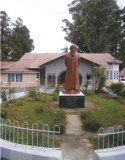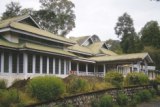Archives
Cultural Roots The Blooming of Awareness
| The Governor’s House in Shillong, destroyed in the 1897 earthquake was rebuilt between 1899 and 1903 and now stands as a shining reminiscent of past architectural heritage |
This has come about at a time when the skyline especially of the capital city of Shillong,has changed considerably with the emerging concrete structures and buildings,some of which are even in violation of the Municipal rules regarding building construction.Even in the remote areas of the state,thatched houses that dot the landscape are rapidly being replaced by tin roof houses and even concrete buildings.It is therefore of outmost importance that some villages having attractive traditional heritage houses,be encouraged in conserving the beauty of thatched houses and huts set in the background of lush green forests and paddy fields.
One of the most imposing thatched structures of the state is the Iing Sad or the Divinity House of the Khasi state of Hima Khyrim located at Smit being the headquarters,25 kms from Shillong.It is here that the religious rites and rituals are performed in the annual festival of ‘Ka Pomblang Bad Shad Khyrim’,also popularly known as the Nongkrem Dance held during the autumn season in the month of November.
The Iing Sad or the Divinity House has a unique architectural style shaped like an overturned boat with thatched roofing with no nails used in any part of the structure except wooden pegs and bamboo strapping.How no iron nails are used in such Khasi religious structures remains an enigma considering the fact that the Khasi Hills have a rich tradition of iron and steel manufacturing.Similar other structures,related to history and culture of the people are still being conserved in other parts of the Khasi and Jaintia Hills in the Ri Hynniewtrep of East Meghalaya.
bamboo strapping.How no iron nails are used in such Khasi religious structures remains an enigma considering the fact that the Khasi Hills have a rich tradition of iron and steel manufacturing.Similar other structures,related to history and culture of the people are still being conserved in other parts of the Khasi and Jaintia Hills in the Ri Hynniewtrep of East Meghalaya.
Usually children are being groomed in such heritage premises in different forms of traditional dance and music and also in sports such as archery so that the present generation becomes aware of their roots and bearings of the present and bloom as the rightful inheritors and caretakers of the richness of their traditional heritage.
It is therefore fit and proper to refer here that the Cultural Resource Conservation Initiative(CRCI),New Delhi,is working towards interdisciplinary community focused at heritage conservation.The sight of young students trailing around with video cameras and filming historical monuments and also retelling folk tales and stories is now in vogue among school and college students in the region and also in other parts of India.
 In another development,the Guwahati College of Architecture,the only architecture college in North East India,along with the Kamla Tabeja Vidyanidhi Institute of Architecture of Mumbai are conducting a study trip this October to Shillong and its surroundings of the architectural design of heritage buildings in Shillong so as to de–layer the history of contemporary Shillong through an analysis of its architectural objects as evidence and find clues to the many forces that have shaped and continue to shape Shillong today.
In another development,the Guwahati College of Architecture,the only architecture college in North East India,along with the Kamla Tabeja Vidyanidhi Institute of Architecture of Mumbai are conducting a study trip this October to Shillong and its surroundings of the architectural design of heritage buildings in Shillong so as to de–layer the history of contemporary Shillong through an analysis of its architectural objects as evidence and find clues to the many forces that have shaped and continue to shape Shillong today.
Nature plays an important and crucial influence on Khasi architecture,especially in the monsoon prone areas of Sohra(Cherrapunjee)which is the wettest place on Earth extending to Mawsynram and Pynursla.The houses in these places are built in a manner to protect from high velocity winds and heavy rains.These houses can also withstand earthquakes especially in the aftermath of the great earthquake on the 12th of June in the year 1897 which was of a magnitude of 8.7 on the Richter Scale,claiming thousands of lives and destroying property in the area besides in other parts of the region.
| The Tara Ghar heritage house ran into a controversy at a proposal to mow it down along with the surrounding environ for raising a modern type assembly legislative building of the state |
The Governor’s House in Shillong,now known as the Raj Bhavan,destroyed in the 1897 earthquake was rebuilt between 1899 and 1903 and now stands as a shining reminiscent of pastarchitectural heritage.Adjacent to the Raj Bhavan is the Tara Ghar heritage house which ran into a controversy at a proposal to mow it down along with the surrounding environ for raising a modern type assembly legislative building of the state.In the vicinity is the Ward’s Lake in the heart of the city which is another heritage site and which has now developed into a centre of tourist attraction.It was William Ward,the Chief Commissioner of Assam who gave the final touch to the construction of Ward’s Lake in the year 1891.
Poet laureate Rabindranath Tagore had visited Shillong three times during the years 1919,1923 and 1927 and the places where he had stayed in Shillong have become historic heritage sites including the Brookside Mansion,Jitbhumi and the Sidley House.Such sites need protection from land grabbing sharks who care less for the preservation of heritage sites in the city and other parts of the state.
The ancient monoliths and sacred forests have become antique treasurers in which stories and legends of important events have been woven along with the passage of time and history.In fact,almost all rivers,waterfalls,hills and mountains have their own heritage tales which are being retold to each generation so as the children and the youth are imbibed with the important significances of the rocks,caves and historical structures which cannot be erased.
A huge tree without roots just cannot survive the ravages of nature.These roots have to be nurtured by each up and coming generation,the creation of an awareness that can inspire today’s young ones to bloom into a future of confidence and pride of their traditional heritage of their land and its people.

